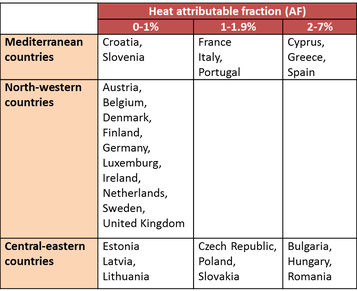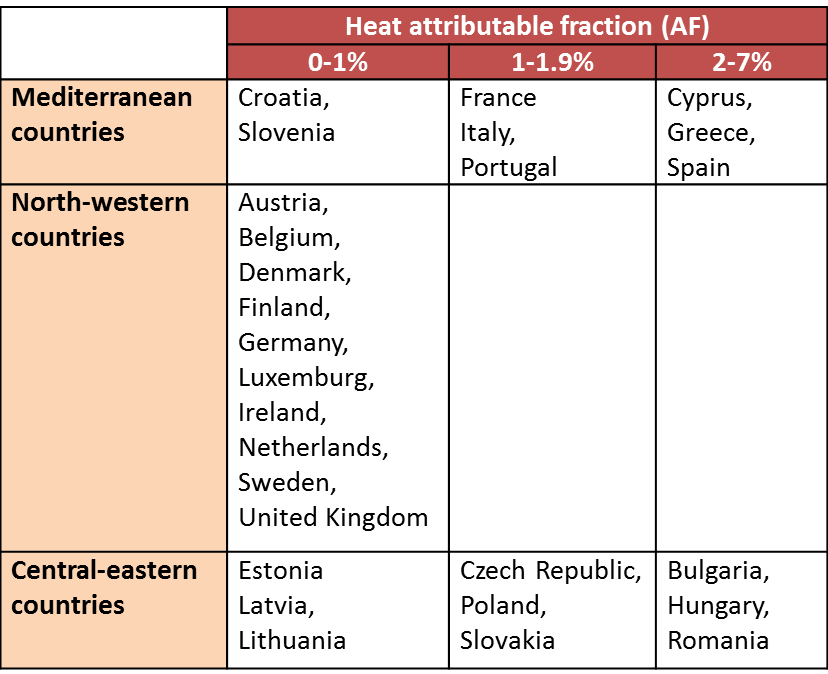Heat Mortality
Increasing heat mortality in Europe under 2°C global warming
Climate change will exacerbate existing heat–health problems, even if global warming is limited to 2°C
Residents of the European Union are at risk from both direct and indirect impacts of climate change (Kovats et al., 2014). One objective of IMPACT2C is to estimate heat mortality from climate change in Europe under a 2°C global warming scenario. The baseline climate (1971–2000) and meteorological projections for future time periods in a 2°C world were considered. In order to account for geographical heterogeneity, the country-specific heat mortality/apparent temperature thresholds and slopes were estimated separately for Mediterranean, northern and central-eastern European countries (Baccini et al., 2008). For each day of the “warm season” (1April–30September), the daily attributable fraction (i.e. the fraction of deaths as a percentage attributable to mean apparent temperature above the threshold) were calculated using five different models.
“Apparent temperature" is the perceived outdoor temperature, caused by the combined effects of air temperature and relative humidity. For each European country, climate model and time period for the IMPACT2C 2°C periods, the number of attributable deaths per year (AD) were calculated. To estimate the attributable deaths, the total heat-attributable deaths by models minus the estimated deaths without climate change were calculated.
This was then converted into a percentage above the threshold, called the attributable fraction (AF). Results: For Europe (which excludes Malta as no data were available), we estimate for the 2°C periods of the five different models an average about 23,100 additional heat deaths in warm seasons per year. Citizens from Mediterranean (Cyprus, Greece, Spain) and central-eastern European countries (Bulgaria, Hungary and Romania) will be most affected by heat due to higher estimated AF from heat (Table1). Even though the AF from heat is less intensive for citizens in other European countries, they will also register more heat deaths during the warm season.
Advocating for further improvement, development and implementation of heat-wave preparedness, planning and response in European countries would lead to a reduction in heat-related mortality . A focus should be placed on developing strong intersectoral coordination, effective early warning and health system response mechanisms as well as surveillance and evaluation measures (Bittner et al., 2014). Long-term planning, including urban planning and housing, becomes even more relevant than before.
References
- Baccini M, Biggeri A, Accetta G, et al. (2008) Heat Effects on Mortality in 15 European Cities. Epidemiology. 2008;19(5).
- Kovats, R.S., Valentini, R., Bouwer, L.M., et al. Climate Change 2014: Impacts, Adaptation, and Vulnerability. Part B: Regional Aspects. Contribution of Working Group II to the Fifth Assessment Report of the Intergovernmental Panel of Climate Change. Cambridge University Press, Cambridge, United Kingdom and New York, NY, USA, pp. 1267–1326.
- Bittner MI, et al. (2014) Are European countries prepared for the next big heat-wave? Eur J Public Health. 24(4):615-9.
Author:
Vladimir Kendrowski
World Health Organisation (WHO) Europe, SwitzerlandMichela Baccini
University of Florence (UniFl), ItalyBettina Menne
World Health Organisation (WHO) Europe, Switzerland
